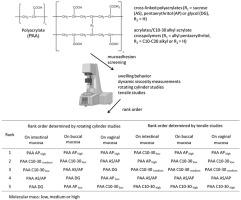International Journal of Adhesion and Adhesives ( IF 3.2 ) Pub Date : 2021-03-15 , DOI: 10.1016/j.ijadhadh.2021.102857 Hung Thanh Lam , Ožbej Zupančič , Flavia Laffleur , Andreas Bernkop-Schnürch

|
Aim
The objective of this study was to evaluate and compare the mucoadhesive properties of ten commercially available polyacrylates including linear polyacrylic acid of 100 and 450 kDa (PAA 100 and 450), with allyl pentaerythritol, allyl sucrose and divinyl glycol cross-linked PAAs (PAA AP, PAA AS/AP, PAA DG) as well as hydrophobically modified cross-linked PAAs (PAA C10-30).
Methods
Swelling behavior, rheological measurements of polymer/mucus mixtures, rotating cylinder studies and tensile studies were performed to evaluate the mucoadhesive properties of PAAs on intestinal, vaginal and buccal mucosa.
Results
Investigations on the swelling behavior revealed that higher degree of cross-linking of PAA and higher degree of alkylation of acrylates/C10-30 alkyl acrylate crosspolymers cause a more pronounced swelling following the rank order: PAA C10-30 high > PAA C10-30 medium > PAA C10-30 low > PAA AP high > PAA AP low > PAA AS/AP > PAA DG > PAA C10-30 very low > PAA 450 > PAA 100. The rank order of dynamic viscosity of polymer/mucus mixtures was PAA C10-30 medium > PAA C10-30 low > PAA C10-30 very low > PAA AP high > PAA C10-30 high > PAA AS/AP > PAA DG > PAA AP low > PAA 450 > PAA 100. Rotating cylinder studies and tensile studies showed that mucoadhesive properties of all tested polymers depended on the type of porcine mucosa and the simulated biological buffer. The experiments on various mucosae showed the highest mucoadhesion of PAA AP high, PAA C10-30 low and PAA C10-30 medium. In contrast, the weakest mucoadhesion was attributed to linear PAA 100 and 450 and PAA C10-30 very low.
Conclusion
Within this study, the mucoadhesive properties of ten different types of polyacrylates were compared with each other facilitating the decision-making for formulation scientists when developing oral, buccal or vaginal mucoadhesive drug delivery systems.
中文翻译:

聚丙烯酸酯的粘膜粘附特性:结构-功能关系
目的
这项研究的目的是评估和比较十种市售聚丙烯酸酯(包括100和450 kDa的线性聚丙烯酸(PAA 100和450))与烯丙基季戊四醇,烯丙基蔗糖和二乙烯基二醇交联的PAA(PAA AP)的粘膜粘附特性。 ,PAA AS / AP,PAA DG)以及疏水改性的交联PAA(PAA C10-30)。
方法
进行了溶胀行为,聚合物/粘液混合物的流变学测量,旋转圆柱体研究和拉伸研究,以评估PAA在肠,阴道和颊粘膜上的粘膜粘附特性。
结果
对溶胀行为的研究表明,PAA的交联度越高,丙烯酸酯/丙烯酸C10-30烷基酯交联剂的烷基化程度越高,则溶胀程度越高:PAA C10-30高 > PAA C10-30中等 > PAA C10-30低 > PAA AP高 > PAA AP低 > PAA AS / AP> PAA DG> PAA C10-30非常低 > PAA 450> PAA100。聚合物/粘液混合物动态粘度的等级顺序为PAA C10 -30中 > PAA C10-30低 > PAA C10-30非常低 > PAA AP高 > PAA C10-30高 > PAA AS / AP>PAA DG> PAA AP低 > PAA 450> PAA100。旋转圆筒研究和拉伸研究表明,所有测试聚合物的粘膜粘附特性均取决于猪粘膜的类型和模拟的生物缓冲液。在各种粘膜上的实验显示PAA AP高,PAA C10-30低和PAA C10-30介质的粘膜粘附力最高。相反,最弱的粘膜粘附性归因于线性PAA 100和450,而PAA C10-30非常低。
结论
在这项研究中,将十种不同类型的聚丙烯酸酯的粘膜黏附特性进行了比较,从而为配制科学家在开发口服,颊或阴道粘膜黏附药物输送系统时的决策提供了便利。











































 京公网安备 11010802027423号
京公网安备 11010802027423号